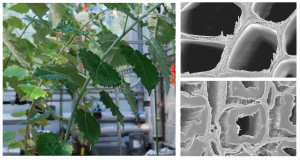
Poplar stems (left) respond to bending stress by producing tension wood. Electron micrographs from a comprehensive BESC study reveal how tension wood (bottom right) develops a secondary cell wall layer, in contrast to normal wood (top right). (Image courtesy of ORNL)
When the DOE JGI published the poplar genome sequence analysis in 2006, it bolstered several research efforts to fully develop that tree’s potential as a candidate bioenergy feedstock.
In a report published online October 4, 2011 in Energy & Environmental Science, DOE JGI’s Gerald Tuskan at Oak Ridge National Laboratory, the project lead on the poplar genome project, and colleagues at the BioEnergy Science Center at ORNL turned their attention on a characteristic of poplar trees that could be useful for increasing available sugars and ultimately, biofuels yield from trees.